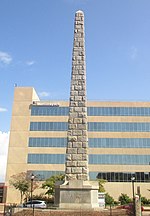Asheville Masonic Temple
Clubhouses on the National Register of Historic Places in North CarolinaHistoric district contributing properties in North CarolinaMasonic buildings in North CarolinaNational Register of Historic Places in Buncombe County, North CarolinaUse mdy dates from August 2023

The Asheville Masonic Temple is a Masonic Temple located in Asheville, North Carolina. Designed by British American architect and Freemason Richard Sharp Smith, the building was opened in April 1915. It is listed in the United States National Register of Historic Places as a contributing building in the Downtown Asheville Historic District.It is a four-story pressed brick building with limestone and grey brick trim, upon a granite foundation. It has a red tile hipped roof above its front portion. The Broadway facade has a two-story portico with paired Ionic columns.
Excerpt from the Wikipedia article Asheville Masonic Temple (License: CC BY-SA 3.0, Authors, Images).Asheville Masonic Temple
Broadway Street, Asheville
Geographical coordinates (GPS) Address Nearby Places Show on map
Geographical coordinates (GPS)
| Latitude | Longitude |
|---|---|
| N 35.598106 ° | E -82.552435 ° |
Address
Broadway Street
28802 Asheville
North Carolina, United States
Open on Google Maps







